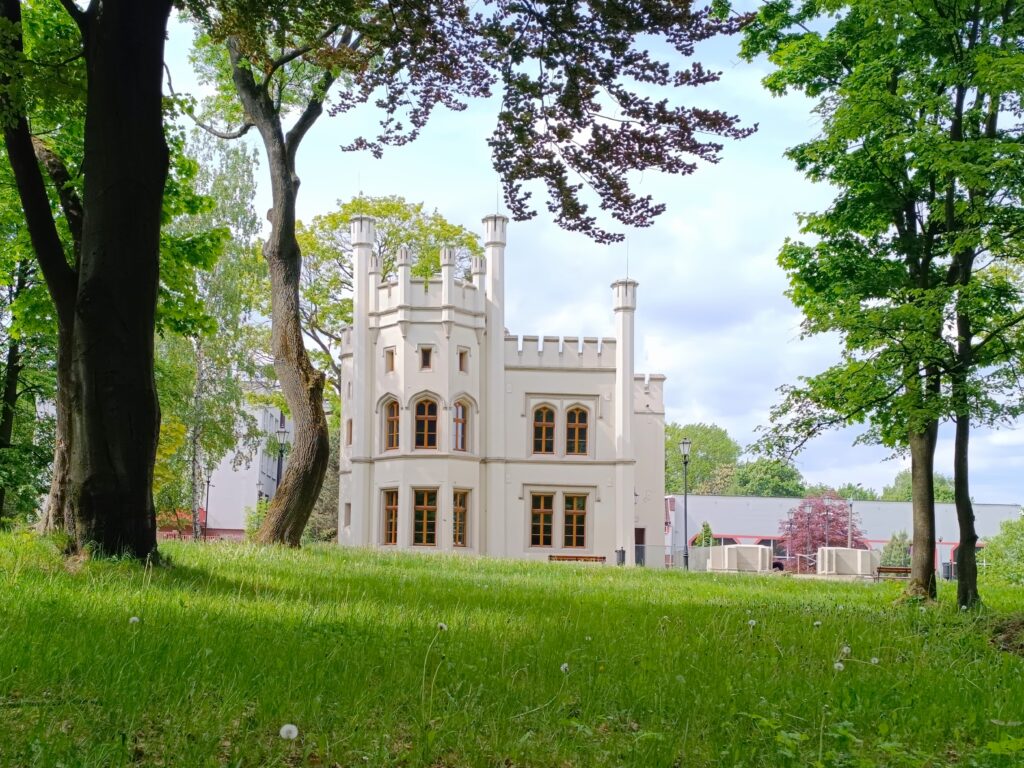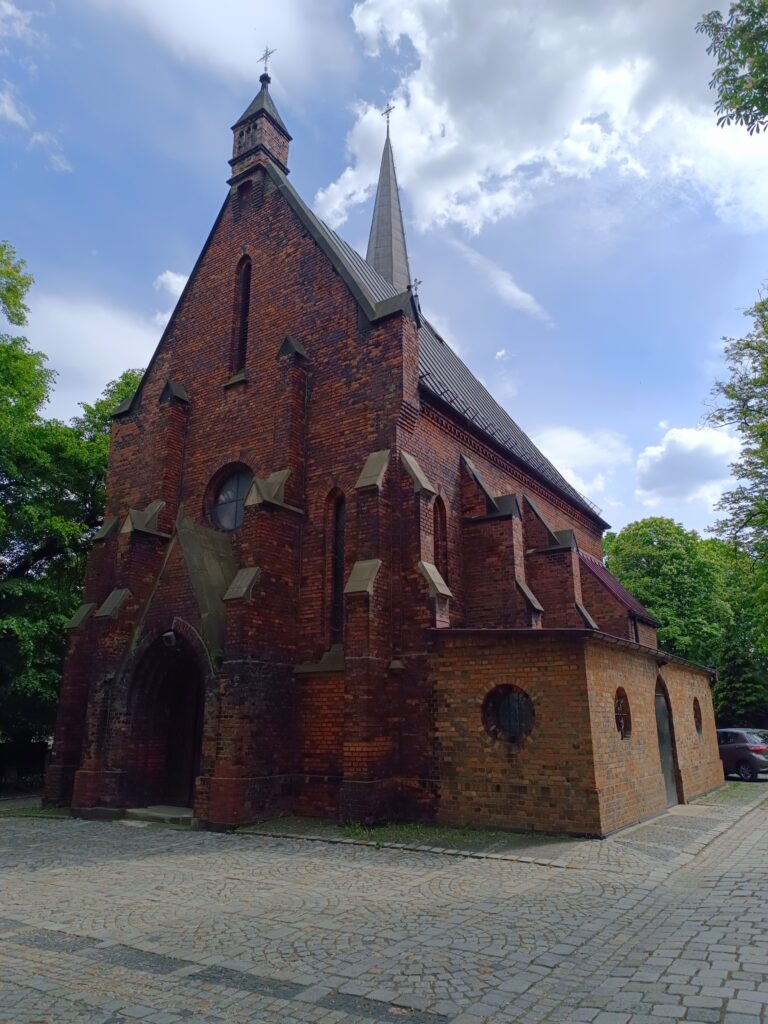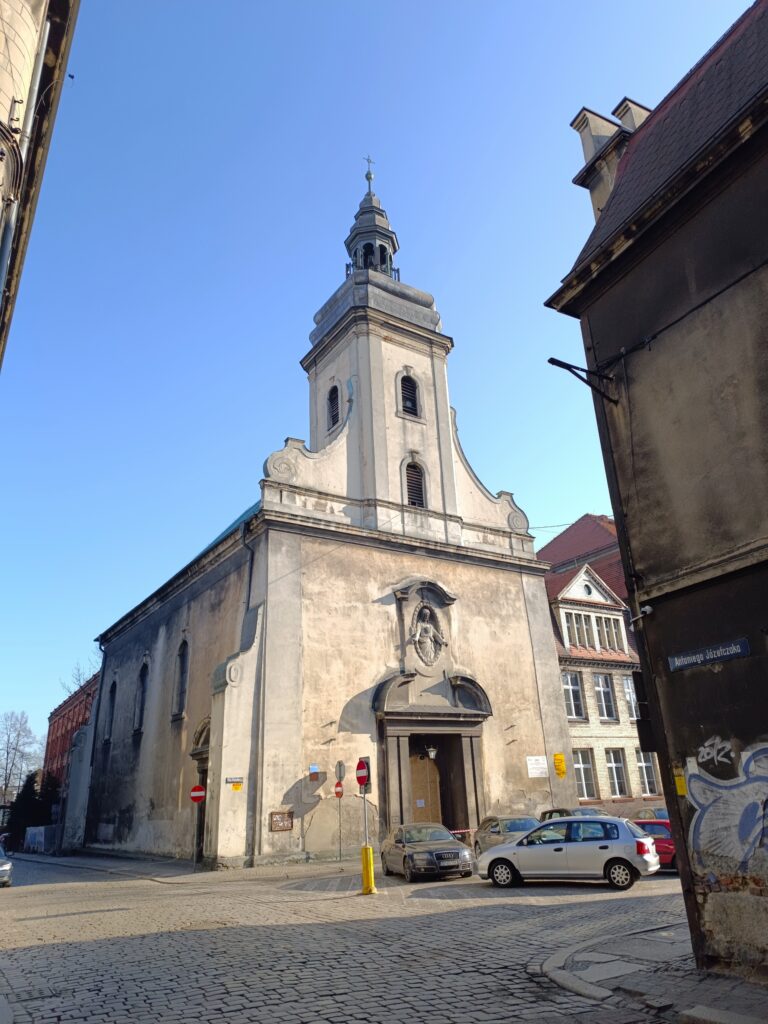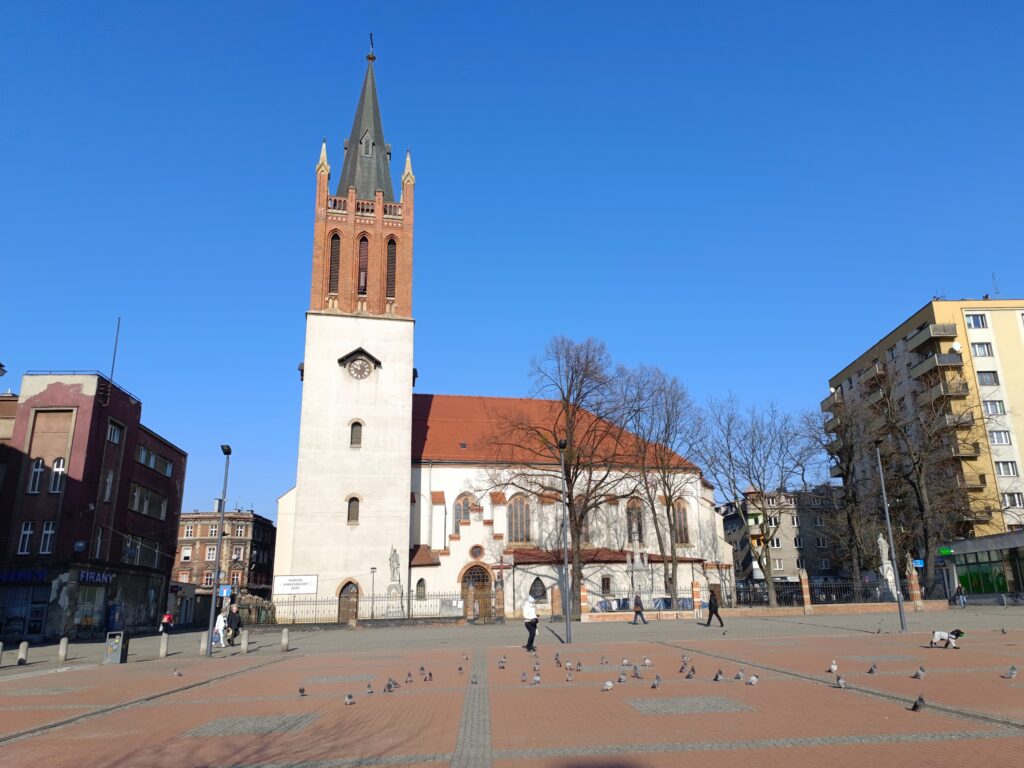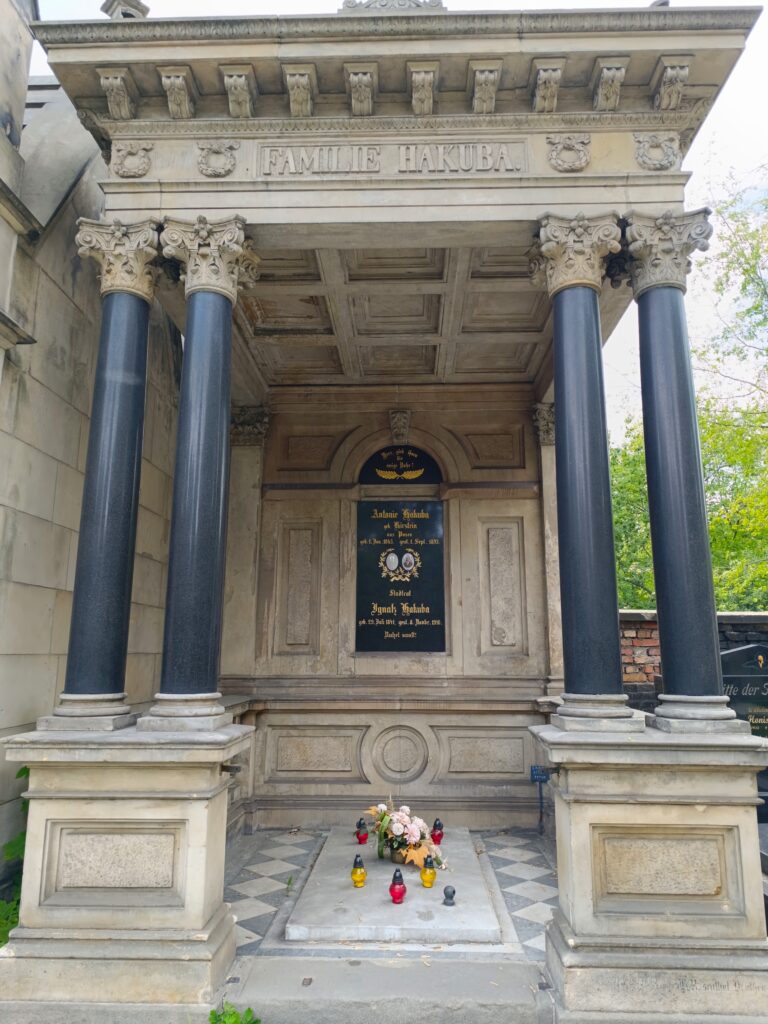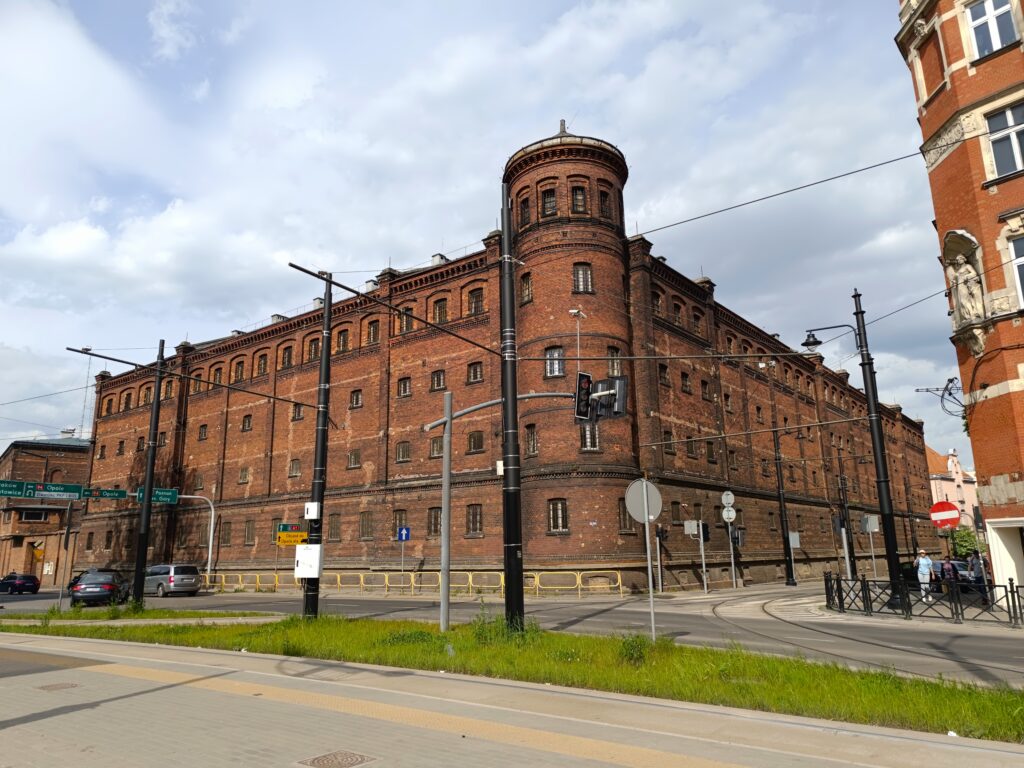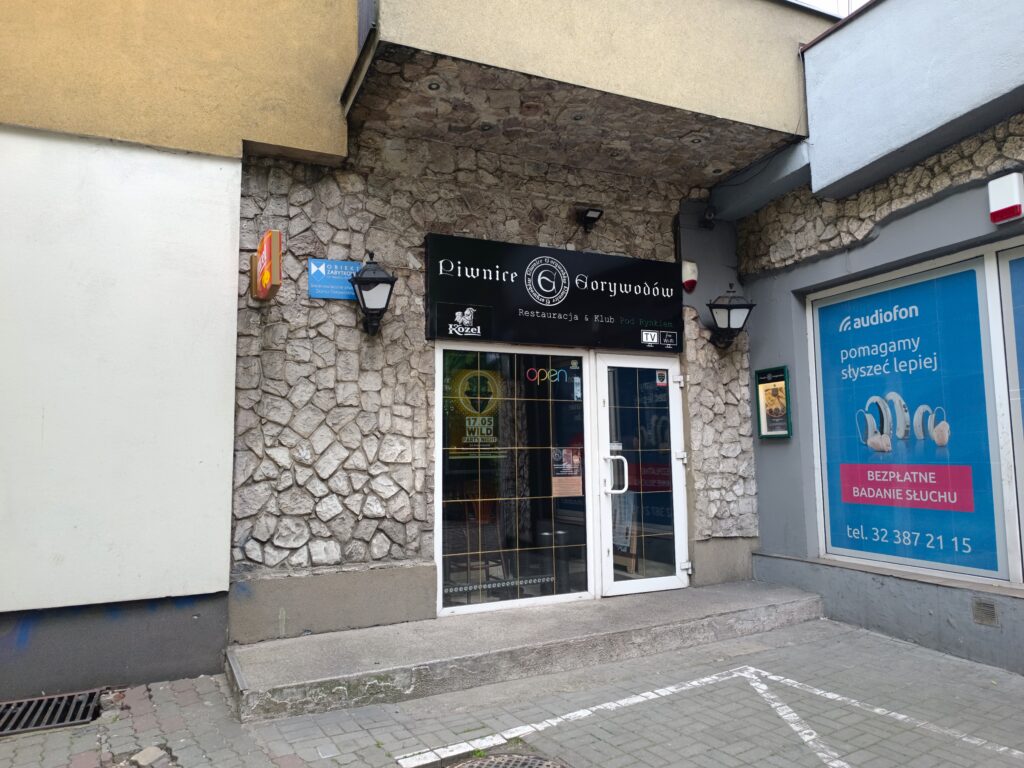All you need to know about the city of
BYTOM
Poland
Sightseeing
Bytom is a city that may at first seem like an unconventional destination—but only at first. Within its borders lie the majestic Tiele-Winckler Palace, a charming medieval market square, and a mysterious 19th-century cemetery, rich with hidden stories.
Curiosities
The city is steeped in legend—one tells of the Corpse Stone, another of a curse cast by the Church in the 14th century. Bytom has also witnessed darker chapters of history, including the tragic events of the Upper Silesian Tragedy. And if you enjoy unusual experiences, visit the medieval cellars—where you can enjoy a truly unique meal!
History
Bytom is one of the oldest cities in Upper Silesia. Its history is a fascinating journey: from the capital of a medieval duchy, through the heights of industrial prosperity, to becoming the most populous district in Prussia.
CONTENTS
SIGHTSEEING
Tiele-Winckler Palace
Admission: 2zł (Paid events inside)
Opening hours: Mon and Thu: 4:00 PM – 6:00 PM
The Tiele-Winckler Palace is a charming site in Miechowice, a district of Bytom. The first palace was built here in the 19th century, founded by wealthy Silesian nobility. It was constructed in the English Neo-Gothic style, and a small park was also established nearby. Unfortunately, the building was burned by the Soviets in 1945 and later blown up—only one outbuilding survived.
It is this outbuilding that is today referred to as the palace. It was renovated only in 2019–2020, and today it serves as a venue for cultural events such as workshops and lectures.
Upper Silesian Museum
Admission: Permanent exhibitions: 10 PLN regular, 5 PLN reduced; Temporary exhibitions: 10 PLN regular, 5 PLN reduced
Opening hours: Tue and Fri: 9:00 AM – 3:00 PM, Wed and Thu: 12:00 PM – 6:00 PM, Sat: 11:00 AM – 4:00 PM, Sun: 12:00 PM – 5:00 PM
Visiting the Upper Silesian Museum in Bytom is the perfect way to spend an afternoon. The facility features a series of exhibitions spread across different floors of the building. Among the permanent displays are: Nature of Upper Silesia, showcasing the region’s local fauna; From the Life of the Silesian People in the 19th–20th Century, presenting the everyday life and customs of the local population; Gallery of Polish Painting, featuring an impressive collection of Polish artworks; The Trace of Generations. From the Synagogue to the Jewish House of Prayer in Bytom, an exhibition exploring the history of the local Jewish community.
In addition to its permanent exhibitions, the museum regularly hosts temporary exhibitions that shed light on the history not only of Bytom, but of the wider world around us.
Admission to the permanent exhibitions is free on Sundays.
Church of the Assumption of the Blessed Virgin Mary
Admission: Free
Opening hours: Masses: Mon–Sat: 7:00 AM and 6:00 PM, Sun and holidays: 7:00 AM, 9:00 AM, 11:00 AM, and 7:00 PM
This is the oldest church in the city, with origins dating back to 1231. It was built in the Gothic style, still visible today in parts of the nave and the presbytery. Over the centuries, the church underwent several expansions—taken over by Protestants in the 17th century, and significantly rebuilt in the 19th century, acquiring Neo-Gothic features. Today, it once again belongs to the Catholic parish.
In the church, it is worth seeing the 15th-century painting of Our Lady of Bytom.
St. Adalbert’s Church
Admission: Free
Opening hours: Masses: Mon–Sat: 6:30 AM, 8:00 AM, and 6:00 PM; Sun and holidays: 8:00 AM, 10:00 AM, 12:00 PM, 6:00 PM, and 8:00 PM
This is a 15th-century church, though its history reaches back two hundred years earlier and is connected with the Franciscans. They settled in Bytom as early as the 13th century and built the former wooden Church of St. Nicholas. After they were expelled in the 15th century, the church was taken over and rebuilt by the Bernardines—creating the present-day temple.
In the 18th century, with Bytom’s takeover by the Protestant Kingdom of Prussia, St. Adalbert’s Church was once again transformed—this time into the Baroque style. In 1833, it was sold to the Evangelical community. After World War II, due to the expulsion of the German population, the church was abandoned. It later returned to Catholic hands, with the Franciscans once again taking it under their care.
The church was renovated as recently as 2025. An interesting feature is the currently sealed crypt beneath the presbytery. Since 1997, the church has also housed relics of St. Adalbert.
Church of the Holy Trinity
Admission: Free
Opening hours: Masses: Mon–Sat: 8:00 AM and 6:00 PM; Sun and holidays: 8:00 AM, 9:30 AM, 11:00 AM, 12:30 PM, and 5:00 PM
This is the youngest of the city’s historic churches. It was built at the end of the 19th century on the site of a former cemetery chapel. Constructed from stone in the Neo-Gothic style, it draws on traditional architectural forms. Most of the church’s interior dates from the 19th century, with one notable exception — a statue of St. Joseph from the 17th century, preserved from the earlier cemetery chapel.
Mater Dolorosa Cemetery
Admission: Free
Opening hours: 7:30 AM – 6:00 PM
When visiting Bytom, it would be a sin not to see the local historic cemetery—its origins go back as far as 1868. It is the city’s most important necropolis—both historically and architecturally. The most distinctive feature is the cemetery chapel from 1882, designed by an architect from Vienna. In addition to it, the cemetery grounds contain numerous 19th- and 20th-century tombs, admired for their intricate architecture. Even the historic fencing of the necropolis is noteworthy. It is, without doubt, a one-of-a-kind monument.
Bytom Market Square
Admission: Free
Opening hours: Open 24 hours
Bytom’s market square dates back to the medieval era. Although it has been rebuilt many times, it has managed to survive numerous disasters, wars, and fires. Several historic townhouses have been preserved to this day—despite many being demolished in the 19th century and replaced with modern buildings, and others being destroyed by the Red Army in 1945.
Notable features of the square include a 19th-century lion sculpture and the remains of a medieval well. Beneath the surface of the square lie buried and almost completely forgotten medieval cellars.
St. Margaret's Hill
Admission: Free
Opening hours: Open 24 hours
A lesser-known attraction in Bytom is St. Margaret’s Hill. This is where the first settlement of Bytom was founded in the 12th century. The location was chosen for strategic reasons—being on a hill made defense easier, and the nearby Bytomka River further hindered enemy attacks. Only later did the town begin to develop, eventually incorporating the original stronghold within its boundaries.
Of course, there are few surviving relics from that era. The only notable site is the Roman Catholic Church of St. Margaret. The original church was founded around 1170 by Bolesław the Curly but was destroyed by the Hussites in the 15th century. No remains of that building have been found to this day.
A new church, also dedicated to St. Margaret, was built in 1881. Constructed in the Neo-Gothic style, it still stands today, surrounded by a local cemetery.
CURIOSITIES
The Long Journey Home of Bytom’s Lion
In the market square of Bytom, one can see a distinctive sculpture — a sleeping lion. This statue dates back to the 19th century and was gifted to the citizens after the Franco-Prussian War of 1870–1871, as a memorial to the people of Bytom who died in the conflict.
The monument survived the following decades, until 1945, when the Red Army entered the city. Fortunately, the Soviets only destroyed the pedestal on which the lion stood — the statue itself was moved to a nearby park. However, in 1953, it vanished completely. It was a difficult time, and people were preoccupied with more pressing issues, so the lion’s disappearance went largely unnoticed.
It wasn’t until 2006 that the sculpture was rediscovered… in Warsaw, placed in front of the entrance to the city zoo. Returning the lion to Bytom was no easy task — problems arose concerning transport and funding. Eventually, a compromise was reached: a replica of the statue would remain in Warsaw, while the original would return to Bytom. However, despite its resources, the capital refused to cover the cost of the replica.
Help came from ING Bank Śląski, which — due to the lion in its logo — agreed to support the creation of the copy. Thanks to this, in 2008, the original lion once again stood proudly in Bytom’s market square, regaining its place as one of the city’s cherished symbols.
Secrets of the 14th-Century Cellars
One of Bytom’s most fascinating historical landmarks is the Gorywod Cellars — medieval, stone-built underground chambers dating back to the 14th century. They were constructed using dolomite, a locally abundant material. Interestingly, palm vaulting was discovered within the cellars — a rare architectural feature in secular buildings of that period. Their presence, along with preserved portals, suggests the building once held exceptional significance in the medieval town.
The later history of the cellars remains unclear until the 18th century, when the Gorywod family — wine merchants — moved into the townhouse above. The cellars’ present-day name comes from this family, who used them to store their goods.
It wasn’t until 1953 that the historical value of these underground chambers was fully recognized. Unfortunately, despite their importance, the city decided to demolish the building above. Luckily, the cellars themselves were preserved and restored.
Today, they house the Gorywod Cellars restaurant, where guests can enjoy a meal surrounded by the ruins of a truly unique medieval setting.
The Legendary Curse Over Bytom
One of the most intriguing stories from medieval Bytom dates back to the 1360s. At that time, a local preacher named Mikołaj of Pyskowice, acting under orders from parish priest Piotr of Koźle, delivered a sermon in which he allegedly insulted the townspeople — accusing them of neglecting their financial duties and demanding higher payments. Outraged, the town authorities arrested both clergymen and sentenced them… to death by drowning.
The priests were thrown into a pond, and when they refused to drown, their heads were brutally smashed with an axe. In retaliation for this act, the Bishop of Kraków placed Bytom under an interdict, banning the city from performing sacraments, granting holy orders, or assigning church benefices. According to legend, the bishop also pronounced a curse: Every time the city rises from ruin, it shall fall twice as hard.
The interdict remained in effect for two years. Bytom suffered heavy economic losses — not only clergy but also merchants avoided the city. Eventually, the townspeople gathered a large sum of money and paid off their debt directly to the Pope, which led to the interdict being lifted. However, the legend of the curse has endured through the centuries.
Interestingly, as recently as 2007, some Bytom residents submitted a formal letter to the Archbishop of Katowice, asking him to request the Pope to officially lift the alleged curse. Of course, the initiative was symbolic and humorous in nature — in reality, the Holy See does not issue curses, nor does it have any formal process for revoking them.
The Mysterious Corpse Stone
At the beginning of the 19th century, Europe was engulfed in the Napoleonic Wars. In 1808, Prussia came under French occupation, and Napoleon’s soldiers were stationed in Bytom. One day, a man named Maciej Spyra left a tavern — slightly drunk, he began singing patriotic Prussian songs.
His evening stroll ended tragically. Maciej encountered a group of equally intoxicated French soldiers. A quarrel broke out, escalating into a fight. Outnumbered, Spyra was beaten to death and robbed.
To commemorate him, his family erected a simple gravestone bearing an inscription in clumsily written Polish:
1808 – MATHIUS SPIERA TU JEST ZABIETI DNIA 30 CZERWCA ROKU
(1808 – MATHIUS SPIERA WAS KILLED HERE ON JUNE 30TH OF THIS YEAR)
Over time, the stone became known as the Corpse Stone (Trupi Kamień) and became the subject of local legends. People claimed that every night at midnight, a small, grey man would appear beside it. The tale was so widely believed that the entire area would empty out after dark.
During the Nazi era, the Corpse Stone was removed as part of efforts to eliminate traces of Polish culture in Upper Silesia. However, after the war, a replica was created, which can still be seen today at 70 Piekarska Street in Bytom. Remarkably, in the 1980s, the original stone was rediscovered and is now preserved in the Upper Silesian Museum.
A Weekend Time Machine
One of the most charming attractions to discover during a visit to Bytom is the city’s public transportation — particularly tram line number 38. Once the shortest tram route not only in Silesia but in all of Poland, its original length was just 1,350 meters, with only four stops.
Today, the line has been slightly extended and includes more stops. However, the main highlight remains the opportunity to ride a historic 20th-century tram. Importantly, on weekdays, only modern trams run on the route. The vintage tram, known locally as the “enka”, appears only on weekends, running every other course — preserving an important part of the city’s heritage.
Soviet Fury in Upper Silesia
In 1945, the Red Army “liberated” Upper Silesia, ending German occupation — but also beginning a new and tragic chapter in the region’s history. As part of war reparations to the Soviet Union, German civilians were to be used as forced labor. In theory, this applied to men aged 17 to 50.
In practice, however, everyone was arrested, regardless of nationality or background. Silesians, Germans, and Poles living in Upper Silesia were all interned. Among the victims were former Silesian insurgents, members of the Polish Home Army, survivors of Nazi concentration camps, repatriates from Western Europe, and even people associated with communist resistance. Arrests took place not only in the Upper Silesian Industrial District but also in other regions like Małopolska. It is estimated that between 40,000 and 60,000 people were deported, with only about one in five returning home.
The miners of Bytom, Gliwice, and Zabrze were hit especially hard. One of the most tragic events was the Upper Silesian Tragedy, with its culmination in the Bytom district of Miechowice. These were not just deportations — they included brutal massacres of civilians.
One of the victims was Father Jan Frenzel, who was tortured and murdered with a shot to the eye. In another horrifying case, a man was forced to watch as Soviet soldiers raped his wife and daughter — afterward, he killed them and committed suicide. Disabled individuals were especially vulnerable, often mistaken for injured Wehrmacht soldiers. In truth, many were miners injured in underground work.
It is estimated that around 380 people were killed in Miechowice alone, though the real number may be as high as 700. Victims were often buried in mass graves without identification, making it difficult to assess the full extent of the atrocities to this day.
HISTORY
The Legend of Bytom’s Origins
According to legend, in the year 1040, Casimir the Restorer was traveling through the lands of what is now Silesia on his way to Kraków. Seeking rest, he decided to stop at one of the local strongholds. However, upon arrival, he found only smoldering ruins. Surprised, he asked his knights what had happened there. They replied that the settlement had been burned down by an enemy — the King of Bohemia.
The prince approached the surviving locals and asked:
— “Was the enemy here?”
— “He was here!” (Polish: „Był tu!”)
Casimir then ordered the rebuilding of the fortress and gave it the name Byłtu, which over time evolved into Bytum, and eventually became the modern name Bytom.
However, it’s likely that the name of the city has even older Proto-Slavic roots. It may derive from the root byto, meaning to be, to exist, or to live. Another theory suggests that Bytom was named after a legendary warrior whose name began with this prefix — possibly Bytomir.
From Stronghold to City
The stronghold in Bytom was most likely founded at the beginning of the 11th century, initiated by Bolesław the Brave. Favorable defensive conditions — especially its location on St. Margaret’s Hill — combined with the presence of an important trade route, contributed to the settlement’s rapid development. By the 12th century, Bytom had become the seat of a castellan, which reflected its growing importance.
Meanwhile, in 1138, Poland underwent feudal fragmentation, granting increasing autonomy — and in some cases, independence — to local dukes. Bytom initially became part of the seniorate province, alongside Kraków, Gniezno, and Gdańsk. However, in 1179, the castellany was handed over to the Duchy of Opole-Racibórz, permanently linking Bytom’s fate with Silesia.
In 1241, like many other towns, Bytom suffered during the Mongol invasion. Nevertheless, this did not stop its growth — just a few years later, the Church of the Assumption of the Blessed Virgin Mary was built, and in 1254, the city was granted Magdeburg rights. These privileges enabled the hosting of assemblies and the expansion of trade.
Silesian Labyrinths of Power
The policy of dividing the state into smaller duchies continued even after the death of the Duke of Opole-Racibórz in 1281. His lands were split among his four sons, which led to the creation of several new duchies — including the Duchy of Bytom, ruled by Casimir of Bytom. To strengthen his position, he built the first ducal castle in Bytom.
Unfortunately, Casimir also chose to divide his territory in a similar way, resulting in the emergence of even more entities — such as the Duchy of Toszek and Duchy of Koźle. Although the rulers of these lands pursued a policy oriented toward Poland, in 1327 they were forced to pay homage to the King of Bohemia, John of Luxembourg. Other Silesian dukes followed suit, which ultimately sealed Silesia’s separation from Poland.
In 1328, the duchies of Bytom, Toszek, and Koźle were reunited under the rule of Władysław of Bytom. Despite promising prospects, Władysław failed to capitalize on them — he soon ran into financial troubles. He first pledged the Duchy of Koźle (which was later taken over by his brother), and then sold Toszek along with its surrounding areas.
Things might have changed during the Polish–Bohemian War (1345–1348). Władysław supported King Casimir the Great of Poland, and although there were some initial successes, Poland failed to regain lasting influence over Silesia. As a result, after the war, Bytom remained under Bohemian rule, and like the rest of Silesia, it was incorporated into the Holy Roman Empire.
A Duchy in Foreign Hands
In 1352, after the death of Władysław, power in Bytom passed to his brother Bolesław, who had already been ruling in Koźle. As a result, the two territories were united to form the Duchy of Bytom-Koźle. In 1354, Bolesław joined King Charles IV of Bohemia on an expedition to Italy. He died there under mysterious circumstances and was buried in the cathedral of Venzone. The lack of a male heir led to another division of the duchy among different branches of the Piast dynasty.
Koźle went to the Piasts of Oleśnica, while Bytom became a co-ownership between the Piasts of Oleśnica and Cieszyn. Even Bytom Castle was split — the western part came under the control of the Oleśnica dukes, while the eastern part was ruled by the Cieszyn branch.
This arrangement lasted until 1459, when Wenceslaus of Cieszyn sold his share in the duchy to the dukes of Oleśnica, making them the sole rulers of Bytom. However, their rule did not last long — in 1475, the duchy was seized by King Matthias Corvinus of Hungary, who later pledged it to a Moravian nobleman. Only in 1498 was Bytom redeemed from that nobleman by John II the Good, Duke of Opole.
A Legacy Without an Heir
John II the Good could be described as an above-average ruler. The annexation of the land of Bytom to Opole was not an isolated incident — in a similar manner, he also acquired Koźle, Toszek, Brzeg, Strzelce, and even Racibórz, thus restoring the former Duchy of Opole-Racibórz. Unfortunately, his greatest failure was the fact that he left no successor.
After his death in 1532, a dispute erupted over who should assume control of this wealthy and expansive territory. The main contenders were George Hohenzollern and Ferdinand Habsburg, the then King of Bohemia. Ultimately, a compromise was reached — the Habsburgs took possession of John’s movable goods, while the Hohenzollerns temporarily assumed control over the duchy as leaseholders.
For reasons unknown, George Hohenzollern harbored a dislike for Bytom. According to some accounts, he founded Tarnowskie Góry — a city intended to rival Bytom. He did not use the title of Duke of Bytom, and in ongoing disputes, he systematically acted to the city’s disadvantage. In the 16th century, this even led to the demolition of Bytom Castle. This diminished the city’s status from that of a ducal seat, and subsequent rulers adopted the title “Lords of Bytom.”
Although the Duchy of Opole-Racibórz returned to Habsburg hands after just two decades, Bytom remained under Hohenzollern control, with efforts made to acquire it as hereditary property. However, the Catholic Habsburgs did not consent — the obstacle was the Hohenzollerns’ conversion to Lutheranism, seen as a threat to the Church. As a result of a compromise, in 1606 the city came under the rule of John George Hohenzollern, who had previously governed in Silesian Krnov.
Bytom Sold: The Birth of a State Country
The early 17th century was marked by escalating religious tensions between Catholics and Protestants. The Thirty Years’ War began, pitting the Habsburg dominion against the Protestant states. The Hohenzollerns immediately sided against the Austrians — John George became the leader of Protestant forces from across Silesia.
After the Protestants’ defeat at the Battle of White Mountain in 1620, John George was sentenced to exile and forced to leave the country. He died shortly thereafter in foreign lands. In the meantime, Emperor Rudolf II of Habsburg pawned Bytom and Tarnowskie Góry to the Upper Silesian family Henckel von Donnersmarck in exchange for a loan. In 1629, the Donnersmarcks officially took ownership of the towns.
The new owners pursued a decisive policy of limiting municipal autonomy. The town council was no longer elected by the residents — instead, it was appointed directly by the landowners. Public gatherings were banned, and disobedience was punished with severe penalties, including fines and imprisonment. Despite this centralization of power, in 1697 the Donnersmarcks were granted the title of Free State Country, elevating them to equal rank with other princes in Silesia.
From State Country to Industrial City
The 18th century marked yet another period of confrontation between the Habsburgs and the Hohenzollerns. The rising Kingdom of Prussia, aiming to take over Austrian Silesia, initiated the Silesian Wars. Initially, the Prussians intended to limit their campaign to Lower Silesia, but their successes exceeded expectations — in a short time, they gained control over nearly the entire region. By 1742, Bytom had already been incorporated into Prussia. The then-lord of the city, Karl Joseph Henckel von Donnersmarck, who had sided with the Habsburgs, was forced to leave Bytom. Only his son, Franz Ludwig, managed to regain the title of Lord of Bytom.
The beginning of the 19th century, however, brought a series of misfortunes. The Napoleonic Wars led to an economic crisis. A great fire struck the city, and in the following years, the population suffered from outbreaks of cholera and typhus.
At the same time, a period of major socio-political transformation began. Between 1806 and 1808, the Stein-Hardenberg reforms were introduced, aiming to modernize the Prussian state. Serfdom was abolished, feudal power was curtailed, and the administration was reorganized. For Bytom, this meant the end of the Donnersmarcks’ direct rule over the city — although they remained influential magnates and owners of industrial enterprises.
In the following decades, Bytom transformed into an important industrial center. In the 1820s and 1830s, new coal mines and metallurgical plants were established, attracting masses of workers. By the 1860s, the Bytom district had a population of 145,000, making it the most populous district in the entire Kingdom of Prussia.
Silesia on the Edge of Nations
At the end of the 19th and the beginning of the 20th century, Bytom was undergoing dynamic development. The first railway connections were established, streets received lighting, secondary schools were opened, and even a tram line was launched. At the same time, industry was flourishing — new mines and factories were systematically put into operation.
Although the city remained under German rule, an active Polish minority thrived in Bytom. Polish-language publications such as Dziennik Górnośląski and Katolik were in circulation, along with organizations promoting Polish culture and identity. The first Upper Silesian branch of the “Sokół” Gymnastic Society — the first physical education organization in Polish history — was also established in the city.
The Polish identity of part of the population became evident after World War I. Following Germany’s defeat and the creation of an independent Republic of Poland, a struggle began over the future of Upper Silesia. Between 1919 and 1921, a series of three Silesian Uprisings took place, during which Polish insurgents attempted to incorporate the region into Poland. The final decision was to be made through a referendum. In the plebiscite, however, as many as 75% of Bytom’s residents voted to remain in Germany.
Although the city remained within the borders of the Weimar Republic, it became surrounded on three sides by Polish territory. This was a globally unique geopolitical phenomenon that led to numerous economic complications, significantly hindering trade and transportation.
Silesian Industry Under the Swastika
After the division of Upper Silesia in 1922, Bytom remained within German borders, yet it played an important role for the Second Polish Republic. The Polish General Consulate was established here, along with several other institutions supporting the Polish minority. Bytom was also home to the first Polish secondary school on German territory in 160 years — a powerful symbol of the rebirth of Polish identity.
The situation changed dramatically after the rise to power of the National Socialists. The NSDAP enjoyed strong support in Bytom — the party achieved one of its highest electoral results nationwide in this city. In 1938, during the so-called Kristallnacht, the Bytom synagogue was burned down, and local Jewish communities faced persecution and economic boycotts. A year later, World War II began.
During the war, Bytom did not play a strategic military role, but labor camps and a subcamp of Auschwitz operated in the area. In 1945, the Red Army entered the city, initiating looting, destruction of buildings, executions, and deportations of residents to the USSR. Shortly afterward, Bytom was incorporated into Poland and was repopulated mainly by settlers from the Eastern Borderlands.
History Rewritten
During the communist era, the city suffered from numerous mistakes of central planning. The authorities annexed neighboring, often independent localities into Bytom, destroying their unique identities and complicating governance. Even worse, intensive coal mining directly beneath urban structures led to severe mining damage — issues that the city continues to grapple with to this day.
It was only after 1990 that Bytom regained local self-governance and began seeking a new path of development. The city became part of the Upper Silesian Metropolitan Union, and later the Górnośląsko-Zagłębiowska Metropolis. Although today it may seem like just one of many cities in the Upper Silesian agglomeration, Bytom remains its oldest and most fascinating link — and perhaps also the most underappreciated.
Oko na Świat © Artur Gołębiowski

